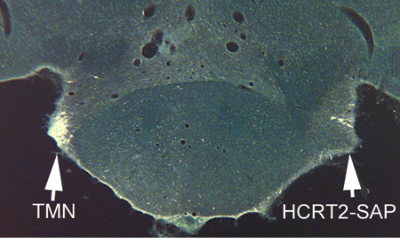Work on hypocretin, or orexin, as it is also known, is some of the most interesting in all of biology these days. When first characterized a mere three years ago by two groups, it was thought to be involved in feeding (hence the name orexin from the Greek orexis meaning appetite). But two articles exploded onto the scene in 1999 and indicated a fundamental role in sleep for the hypocretin/orexin receptor axes. Chemelli et al. reported that knocking out the orexin gene produced mice that suffered from narcolepsy.1 In a prominent model of narcolepsy, some dobermans are found to lapse into a cataplectic state while doing things like running after a ball thrown by their master. Lin et al. used positional cloning to determine that narcolepsy in this astounding model is due to a mutation in the hypocretin/orexin receptor gene.2 These reports clearly put orexin/hypocretin into the narcolepsy mix. Thannickal et al. then reported that missing neurons were the problem in the human disease; that hypocretin/orexin neurons were depleted.3 These new discoveries make the sleep field into something to watch for incredible new results.


Because of the new, exciting work on this system, Peter Shiromani approached Advanced Targeting Systems to request that we construct a molecule that would remove orexin/hypocretin receptor-expressing neurons. He reports on the properties of this targeted cytotoxin in recent issues of Brain Research and the Journal of Neuroscience.4,5 It turns out that hypocretin-2/orexin B-SAP (Orexin- SAP, Cat. #IT-20) is able to eliminate specifically orexin receptor-expressing neurons. Interestingly, these neurons also contain orexin, probably for some sort of feedback loop mechanism, so that, like in the human disease, orexin neurons are lost also. The rats treated with this material injected in the lateral hypothalamus have narcoleptic symptoms and will fall directly into REM sleep while happily munching on rat chow (videos available at www.jneurosci.org).5
This new tool binds best to the hypocretin-2/orexin 2 receptor, but still has affinity for hypocretin-1/orexin 1 receptor. These are G protein-coupled receptors, and, as seen with the other peptide toxins from ATS that target these receptors—SP- SAP (Cat. #IT-07), SSP-SAP (Cat. #IT-11), dermorphin-SAP (Cat. #IT-12) and corticotropin releasing factor- SAP (Cat. #IT-13)—upon ligand binding, the complex is rapidly internalized. The internalized saporin then inhibits protein synthesis by ribosomal inactivation and the target cell dies. The figures provided here by Dr. Shiromani show the remarkable specificity and potency of orexin-SAP. It provides a simple model for narcolepsy and is destined to become an invaluable tool for the study of the role of hypocretin/orexin receptor- expressing neurons wherever they may occur.
References
- Chemelli RM, Willie JT, Sinton CM, Elmquist JK, Scammell T, Lee C, Richardson JA, Williams SC, Xiong Y, Kisanuki Y, Fitch TE, Nakazato M, Hammer RE, Saper CB, Yanagisawa M (1999) Narcolepsy in orexin knockout mice: molecular genetics of sleep regulation. Cell 98:437-451.
- Lin L, Faraco J, Li R, Kadotani H, Rogers W, Lin X, Qiu X, de Jong PJ, Nishino S, Mignot E (1999) The sleep disorder canine narcolepsy is caused by a mutation in the hypocretin (orexin) receptor 2 gene. Cell 98:365-376.
- Thannickal TC, Moore RY, Nienhuis R, Ramanathan L, Gulyani S, Aldrich M, Cornford M, Siegel JM (2000) Reduced number of hypocretin neurons in human narcolepsy. Neuron 27(3):469-474.
- Gerashchenko D, Salin-Pascual R, Shiromani PJ (2001) Effects of hypocretin-saporin injections into the medial septum on sleep and hippocampal theta. Brain Res 913:106-115.
- Gerashchenko D, Kohls MD, Greco M, Waleh NS, Salin-Pascual R, Kilduff TS, Lappi DA, Shiromani PJ (2001) Hypocretin-2-saporin lesions of the lateral hypothalamus produce narcoleptic-like sleep behavior in the rat. J Neurosci 21(18):7273-7283.
